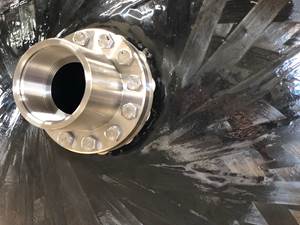Quay cable tray: Composites upgrade container ship terminal
When the Cape Town, South Africa, Transnet National Ports Authority began a 12-month effort to expand its facility and upgrade its existing quays (wharfs), engineers realized that the Authority had a safety problem at its main container quay. Composites provided the solution.
In South Africa, the Transnet National Ports Authority of Cape Town operates a busy port with considerable container ship traffic. When it began a 12-month effort with a local civil engineering company to expand its facility and upgrade its existing quays (wharfs), engineers realized that the Authority had a safety problem at its main container quay: A raised cable tray runs along the quay’s edge. More than 1,200m/3,900 ft long and 3m/10 ft wide, the tray contains the electrical cables that power the large, rail-mounted gantry cranes used to load and unload ships. The tray was a serious trip hazard for workers. In search of a safer solution, the engineering company approached Cape Town-based composite materials supplier and distributor AERONTEC cc.
“Engineers had considered pouring a concrete layer at 190 mm [7.5 inches] thick to bring the quay edge level with the cable tray and the crane rail,” says Graham Blyth, Aerontec’s owner. But that solution weighed in at about 1,000 tons, he recalls. The quay’s cantilevered deck and supporting piles weren’t designed to carry the additional weight. Further, he notes, the concrete’s “28-day cure time would have interfered with berthing ships.”
The cable tray problem needed a solution that would be not only light in weight, but also provide safe footing and permit access to existing manholes and fire hydrants, yet be cost-effective and easy to install. The Ports Authority further specified that any seawater that might wash over the installation should drain away quickly, with minimal corrosion. Perhaps the toughest requirement, however, was that the solution should be strong enough to bear loads of up to 36.3 metric tonnes (80,028 lb) in the event a shipping container is placed, or dropped, within the cable tray area. Finally, the structure should be replaceable, if damaged, and prevent damage to the quay’s underlying concrete surface.
An iterative design and testing process resulted in large, monolithic resin-infused, fiberglass-reinforced polymer (FRP) panels. The 32-mm/1.5-inch thick slabs, formed from woven glass roving and isophthalic polyester resin, were coated with a UV-stabilized iso-NPG (neopentyl glycol) and a nonslip grip finish and drilled to create drainage holes. The reinforcement was woven to Aerontec’s specification and supplied by Vision Composites (Winchester, U.K.) The resin, gel coat and flow-coating materials were sourced from two suppliers: NCS Resins (Pinetown, South Africa) and Scott Bader Company Ltd.(Northamptonshire, U.K.). Aerontec partnered with composites fabricator MMS Technology (Centurion, South Africa) to manufacture and waterjet cut 1,161 panels of varying sizes, which were numbered for installation. Blyth explains that each panel was raised to the specified height using stepped solid feet, bonded to the panel underside; the stepped feet were cored with a vertical pultruded FRP rod. “The quay varies 80 mm [3.2 inches] in height over its surface,” he points out. “We needed to be virtually level with the crane rail to eliminate any trip hazard, so we bonded GFRP shims to the stepped feet to keep the panels level,” he adds.
Some panels required cutting to accommodate the quay bollards (thick, yellow curved posts in photos), and in other panels, openings were cut and fitted with hinged lids for manhole/fire hydrant access. A 300-mm/12-inch gap was left between the panels adjacent to the crane rail and the panels at the water’s edge, to accommodate the crane’s electrical cables. A stiff rubber “Panzer” belt covers the gap, and the cranes are fitted with onboard lifters that bend the belt up out of the way as the crane rolls through on the rails (see the middle photo).
The total weight of all the composite panels was just 226 metric tonnes (500,000 lb) — within the quay’s weight constraint — and the entire project was completed on schedule and within budget.
“As far as I know, this is the first time a project of this type has ever been undertaken in the world,” concludes Blyth. “And I believe it was also the biggest single composites job ever completed in South Africa.”
Related Content
Co-molding SMC with braided glass fiber demonstrates truck bed potential
Prepreg co-molding compound by IDI Composites International and A&P Technology enables new geometries and levels of strength and resiliency for automotive, mobility.
Read MorePlant tour: Airbus, Illescas, Spain
Airbus’ Illescas facility, featuring highly automated composites processes for the A350 lower wing cover and one-piece Section 19 fuselage barrels, works toward production ramp-ups and next-generation aircraft.
Read MoreInfinite Composites: Type V tanks for space, hydrogen, automotive and more
After a decade of proving its linerless, weight-saving composite tanks with NASA and more than 30 aerospace companies, this CryoSphere pioneer is scaling for growth in commercial space and sustainable transportation on Earth.
Read MoreWelding is not bonding
Discussion of the issues in our understanding of thermoplastic composite welded structures and certification of the latest materials and welding technologies for future airframes.
Read MoreRead Next
Ultrasonic welding for in-space manufacturing of CFRTP
Agile Ultrasonics and NASA trial robotic-compatible carbon fiber-reinforced thermoplastic ultrasonic welding technology for space structures.
Read MoreScaling up, optimizing the flax fiber composite camper
Greenlander’s Sherpa RV cab, which is largely constructed from flax fiber/bio-epoxy sandwich panels, nears commercial production readiness and next-generation scale-up.
Read MoreNext-gen fan blades: Hybrid twin RTM, printed sensors, laser shock disassembly
MORPHO project demonstrates blade with 20% faster RTM cure cycle, uses AI-based monitoring for improved maintenance/life cycle management and proves laser shock disassembly for recycling.
Read More












